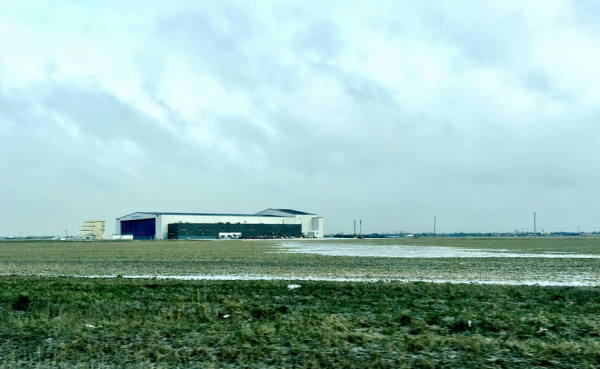ED: This op-ed by Shane Mitchell regarding Windsor’s “Mega-hospital” debate is a microcosm of the poor land use planning many Canadian cities and towns suffer from. Do we want to use infrastructure projects to help revitalize the cities we’ve spent a tremendous amount of resources, money and effort building, or do we abandon them for more sprawl? Windsor’s mayor, a proponent of locating the hospital in a farmer’s field, recently moved to punish Windsor Business Improvement Areas that supported a city location.
Mitchell is a an architectural project manager and founding member of CAMPP – Citizens for an Accountable Mega-Hospital Planning Process – a citizen-led group spearheading the debate about good planning surrounding Windsor’s controversial hospital project.
Windsor is a small Ontario city of approximately 220,000 inhabitants located at the southernmost point of Canada, tucked in under Detroit. Famous for Canadian Club Whiskey and the “Big 3” automobile manufacturers, Windsor is somewhat of a stereotypical rust-belt manufacturing city. Like many cities of its kind, Windsor has experienced a major decline of its urban centre – while downtown and most of the surrounding neighbourhoods have struggled for decades, the suburbs surrounding Windsor have grown exponentially. In fact, Windsor’s population hasn’t grown much since 1970. However, the greater region outside of the city, known locally as “The County”, hosts a number of charming small towns, many with vibrant main-streets. These towns have also seen their fair share of suburban style growth disproportionate to that within their urban centres. The entire Windsor-Essex region has for years grown much like the rest of Canada, dependent almost entirely upon the automobile. Downtowns here could use a boost.
It was in 2013 when most first heard of the plan for a new hospital development in Windsor that would consolidate Windsor’s two major hospitals into one. For myself, a project manager for a small architectural firm and a self-proclaimed urbanist, it was an exciting opportunity for my city, but also something that deeply concerned me. It was the description of the land requirements within the report prepared by our local hospital authority that raised a red flag: “sixty greenfield acres”. At that time I began writing my first guest column on the topic in the Windsor Star. I knew that if our new and only hospital were to be moved away from downtown to a remote location far from the city centre, Windsor’s future would be in peril.
If a suburban lot is selected we will continue to promote a model of sprawl and build in an auto-centric fashion. We will continue to consume valuable agricultural land, and to build in a wasteful low-density fashion, as the city’s core will continue to empty.
If we insist that the new facility be constructed in an urban location, we will be saying that our city matters, that the precious agricultural land that sustains us is valuable, and that we wish our neighbouring communities to grow into strong towns and cities.
Shane Mitchell – Windsor Star – March 24th 2013
For the next three years many from the community came together and formed a group dedicated to advocating for an urban site. CAMPP or Citizens for an Accountable Mega-Hospital Planning Process was formed to educate and advocate for good urban planning, social equality, environmental sustainability and fiscal responsibility in the planning of this new facility. Residents and businesses joined the effort dedicated to the future of the city, but June in 2016 the hospital authority announced what was our worst fear: both of Windsor’s remaining hospitals would be shuttered and new hospital would be built upon, yes, “60 acres of greenfield land” located on the outskirts of town out past the airport.
Fast forward to present day and a few things have happened. The hospital authority has made every effort to push forward their plan, and to do so they began a campaign to get support from the Windsor-Essex region, threatening that if anyone questioned the location, the project would be shelved by the provincial government. It was a campaign that pitted urban residents and business owners against those in the county and the suburbs. During this time CAMPP has continued its effort to “take a stand for the city”. Today as I write this, we are awaiting a hearing to appeal the decision, but the campaign to shutter services in downtown Windsor, leaving the city centre with only an urgent care centre and mental health facility, pushes forward and many residents, particularly those from towns and suburbs that surround Windsor, support the plan.
On taking a stand for the city
Windsor has struggled for decades. While the city has some beautiful neighbourhoods and pockets of great walkable urbanism, many urban areas are blighted and underutilized. This unfortunate situation has left many people from suburbs and County alike with an absolute disdain for urban Windsor. So one can only imagine why disassembling the city – removing its hospitals – is OK for many people in this region. It would mean that they no longer need to travel into the city for services, and after all, the new hospital would be located only a few kilometers from the area’s main, popular strip of big box stores.
Sadly, if the plan proceeds, I fear my city is doomed to continue the process of becoming a “non-city” and nothing more than a fragmented version of what was once a vibrant and beautiful city. However, hope is not lost and the fight for the city is not over. Windsor has a tremendous opportunity. As the citizens and business owners of urban Windsor gear up to defend Windsor in the fight for an urban future, our small city at the end of the 401 could become a precedent for the future of institutional development in Ontario.
Windsor isn’t the only urban centre threatened by plans to close their urban hospital: Bracebridge, Huntsville, Collingwood, the Niagara region and others are fighting similar battles. Windsor might not seem all that important in the world of urban progress, but it very well may soon become an example for other communities fighting to keep their downtown institutions open or perhaps that neighbourhood school from being shuttered. Windsor’s fight is about a problem that plagues us all, that is, the disassembly of our cities. That would waste all the effort and money we spent to build them up in the first place.



4 comments
“Local hospital authority ” ? Who are these people really? Powerful, Rich individuals trying to make mega-dollars anyway they can? Who doesn’t care who they step on to get rich? Mr. Mitchell has uncovered a shady deal in the works in my opinion and exposed a very powerful clique,(which will never be exposed because of power) that has our elected politicians (not all) under their control and needs to be stopped. They do have a name, we peons of the world have only been able to come up with a 100% accurate name, and that is THE 1%ERS. Campp has my support. You should too for all of Essex/Kent/Lambton sake! We deserve more than one hospital. Hell London has 2 plus 3 specialty hospitals. Ottawa has 4 plus 4 specialty ones. So why does all of Essex county only merit one?
Thank you for this article! Fully agreed. Sprawl is slowly killing communities, not to mention the environment and even the fiscal sustainability of cities.
In-fill development is where every city should start. We need a moratorium on greenfield development.
Then there is the centralization fetish of accountants and MBAs. Centralization is not automatically an efficiency gain. It has to make sense! Smaller, local hospitals make much more sense–most care can be given in a less intensive setting.
It’s so frustrating and is really a case of the province talking out of both sides of its mouth with “Place to Grow” and then doing quite the opposite.
Windsor/ Essex County needs two new hospitals.
One in the county and one in Windsor.
The location that is now proposed for the new hospital is in land right across the street from the Windsor Airport.
The AZR of Ontario ( Airport Zoning Regulations of Ontario) have official limits on the height of any buildings or trees in the areas near an airport. Safety and noise are a vital concern. A possible 14 story building may be a safety hazard.
In Michigan any buildings within 2 miles of an airport can not exceed 30 feet ( or 3 stories ) in height.
A second hospital is needed in the county in either the Essex or Leamington area.